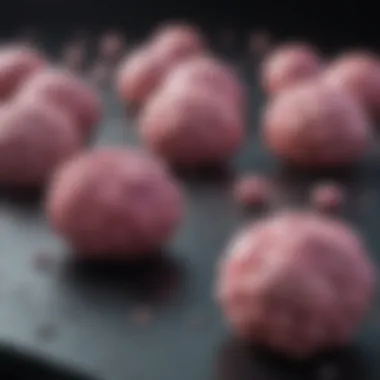IDH1 Inhibitors in CholangioCarcinoma: Insights & Future


Intro
Cholangiocarcinoma is a complex and aggressive cancer, arising from the biliary epithelial cells. It often presents therapeutic challenges due to its late diagnosis and unique biological characteristics. The emergence of ID inhibitors as a promising treatment approach has sparked considerable interest in the scientific community. As researchers investigate the molecular underpinnings of cholangiocarcinoma, understanding the role of ID mutations becomes vital. This article delves into the significance of ID inhibitors, exploring current research and potential future directions in therapy.
Overview of Research Topic
Brief Background and Context
Cholangiocarcinoma is categorized into intrahepatic and extrahepatic types, each with distinct clinical features. These tumors frequently harbor mutations in the ID gene. ID is crucial in cellular metabolism, influencing the tumor microenvironment and pathways of cancer progression. Targeting ID mutations may offer novel therapeutic avenues, transforming treatment strategies that currently rely on surgery and adjuvant chemotherapy.
Importance in Current Scientific Landscape
Highlighting the role of ID inhibitors is essential in the broader context of precision medicine. The recent advancements in molecular biology enable a more tailored approach to cancer treatment. By focusing on specific genetic alterations like ID, researchers can develop targeted therapies aimed at improving patient outcomes. The investigation into the effectiveness of ID inhibitors in cholangiocarcinoma aligns with ongoing efforts to enhance the overall understanding of this malignancy.
Methodology
Research Design and Approach
The article synthesizes findings from various studies examining ID mutations in cholangiocarcinoma. A systematic literature review provides a foundation for understanding the significance of these mutations and the response to ID inhibitors. The analysis covers both preclinical and clinical trials, offering insights into the potential efficacy of these treatments.
Data Collection Techniques
Data for this research is gathered from reputable scientific databases, clinical trials registries, and peer-reviewed journals. Emphasis is placed on recent studies to ensure that the information reflects the current landscape of ID inhibition in cholangiocarcinoma. Key terms such as "ID inhibitors" and "cholangiocarcinoma treatment" are utilized to optimize search results and enhance relevance for readers seeking detailed insights on the topic.
According to recent studies, targeting ID mutations in cholangiocarcinoma could significantly alter therapeutic outcomes and establish a basis for innovative treatment protocols.
Through continued research and collaboration, the therapeutic landscape surrounding ID inhibitors may evolve, providing hope for patients diagnosed with this challenging cancer.
Preamble to CholangioCarcinoma
CholangioCarcinoma is a significant health concern, primarily due to its often late diagnosis and poor prognosis. It originates in the bile ducts, making it a rare yet aggressive malignancy. Understanding cholangiocarcinoma is essential as it lays a foundation for exploring potential treatment options, including ID inhibitors. This section aims to define the disease, provide insights into its epidemiology, and elaborate on its clinical presentation. By doing so, the article prepares the reader for deeper discussions about how ID inhibition can influence treatment strategies and patient outcomes.
Definition and Classification
CholangioCarcinoma refers to cancer that originates in the biliary epithelial cells. It can be classified into two main types: intrahepatic and extrahepatic cholangiocarcinoma.
- Intrahepatic cholangiocarcinoma occurs within the liver and is often associated with chronic liver diseases, such as hepatitis and cirrhosis.
- Extrahepatic cholangiocarcinoma arises outside the liver and further categorizes into perihilar and distal types based on their location relative to the common bile duct.
Understanding these classifications is crucial, as they can influence prognosis and treatment options.
Epidemiology and Risk Factors
The incidence of cholangiocarcinoma is low in the general population, yet it varies by geography. It is more prevalent in Southeast Asia, where liver fluke infections are common.
Some notable risk factors include:
- Chronic liver diseases
- Primary sclerosing cholangitis
- Exposure to certain chemicals
- Viral infections, such as Hepatitis B and C
These factors contribute to both the development and progression of the disease. Awareness of these risks can aid in patient screening and potential early intervention strategies.
Clinical Presentation and Diagnosis
Symptoms of cholangiocarcinoma can be nonspecific and often resemble benign conditions. Patients may present with:
- Jaundice
- Abdominal pain
- Weight loss


Diagnosis often involves imaging studies like MRI or CT scans, and sometimes endoscopic procedures.
Early detection remains a challenge, as symptoms may not appear until the disease is advanced.
A comprehensive understanding of these aspects of cholangiocarcinoma paves the way toward exploring the potential role ID inhibitors can play in its treatment.
Molecular Pathogenesis of CholangioCarcinoma
Understanding the molecular pathogenesis of cholangiocarcinoma is crucial in recognizing the underlying mechanisms that drive this aggressive cancer. This knowledge provides the basis for targeted therapies, highlighting the potential of ID inhibitors as a viable treatment option. Through the exploration of genetic alterations and mutations, especially those within the ID gene, we can identify key pathways that contribute to tumor development and progression.
Genetic Alterations in CholangioCarcinoma
Cholangiocarcinoma is characterized by a variety of genetic alterations that play a significant role in its progression. Notably, mutations in the ID gene are among the most frequently observed changes in this type of cancer. The presence of ID mutations not only informs diagnosis but also opens avenues for targeted therapeutic strategies.
Common genetic alterations include:
- ID mutations
- KRAS mutations
- FGFR2 fusions
- TP53 mutations
These alterations influence biochemical pathways, promoting oncogenesis and affecting tumor behavior. The presence of these mutations may also correlate with patient prognosis and response to treatment. Thus, a comprehensive understanding of these genetic aspects is important for developing more effective strategies in combating cholangiocarcinoma.
Role of the ID Gene
The ID gene encodes isocitrate dehydrogenase 1, an enzyme involved in metabolic processes that convert isocitrate to alpha-ketoglutarate. Mutations in this gene lead to the production of an oncometabolite, 2-hydroxyglutarate (2-HG), which disrupts normal cellular functions.
The role of the ID gene in cholangiocarcinoma is multifaceted. It is not only a marker of tumor presence but also a potential therapeutic target. By inhibiting this mutated enzyme, it may be possible to reduce the levels of 2-HG and restore normal metabolic processes. This makes ID a gene of significant interest in the context of treatment development.
Biological Impact of ID Mutations
The biological consequences of ID mutations are profound. The accumulation of 2-HG affects various cellular pathways, including those involved in cell cycle regulation and apoptosis. This oncometabolite can lead to changes in histone and DNA methylation patterns, further driving tumorigenesis.
Key impacts of ID mutations include:
- Altered cellular metabolism
- Dysregulation of epigenetic modifications
- Changes in tumor microenvironment
As a result, tumors harboring ID mutations exhibit distinct characteristics compared to their wild-type counterparts. These differences necessitate targeted therapeutic approaches that can specifically address the unique biology of ID-mutant cholangiocarcinoma.
This understanding of molecular pathogenesis not only aids in identifying patients who may benefit from ID inhibitors but also illuminates the broader spectrum of molecular targets for future research.
In summary, the molecular pathogenesis of cholangiocarcinoma, particularly the genetic alterations and the role of ID, forms a critical foundation for exploring targeted treatment strategies, such as ID inhibitors. By delving into these molecular mechanisms, we can better understand the complexity of cholangiocarcinoma and enhance the prospects for improved patient outcomes.
ID Inhibitors: Mechanism of Action
Understanding the mechanism of action of ID inhibitors is crucial for appreciating their role in treating cholangiocarcinoma. The ID gene, when mutated, produces an enzyme that alters metabolic pathways in tumor cells, leading to increased levels of 2-Hydroxyglutarate (2-HG). This accumulation contributes to tumor growth and progression. Therefore, targeting ID with specific inhibitors offers a promising therapeutic strategy aimed at reversing some of these metabolic alterations and hampering tumor proliferation.
Overview of ID Inhibitors
ID inhibitors are targeted therapies specifically designed to interfere with the mutated ID enzyme's function. Currently, several ID inhibitors, such as Ivosidenib and Olutasidenib, are being explored in clinical trials. These drugs selectively inhibit the mutated form of the enzyme, thereby reducing the production of 2-HG. Lowering 2-HG levels can potentially restore normal cellular differentiation and decrease pathological proliferation of cholangiocarcinoma cells.
Biochemical Pathways Affected by ID Inhibition
The bifurcation in cellular metabolism post-ID mutation implicates various biochemical pathways that can be positively modulated through inhibition. Notably, the following pathways are affected:
- TCA Cycle Restoration: ID inhibition can restore normal activity in the tricarboxylic acid (TCA) cycle, allowing for better energy production and cellular functioning.
- Reduction of Oncometabolites: By decreasing 2-HG levels, ID inhibitors may also mitigate the effects of oncometabolites that contribute to an oncogenic environment.
- Modulation of Epigenetic Changes: ID mutations are linked to specific epigenetic modifications. Inhibiting the enzyme has the potential to reverse these changes.
This modulation could create a less toxic environment for normal cells while selectively targeting malignant ones.
Expected Outcomes of ID Targeting


The expected clinical outcomes from targeting ID in cholangiocarcinoma involve not just tumor reduction but improved quality of life for patients. Potential benefits include:
- Tumor Shrinkage: Preliminary trials suggest that patients might experience significant tumor reduction.
- Prolonged Survival: With effective ID inhibition, there could be an extension in overall survival rates, particularly in cases where standard therapies have failed.
- Improvement of Symptoms: Patients may report an alleviation of symptomatic burden associated with tumor growth.
Clinical studies are essential to substantiate these outcomes further and evaluate the long-term effects of ID inhibitors in a broader patient population.
In summary, the mechanistic understanding of ID inhibitors reveals their potential in altering the course of cholangiocarcinoma by targeting specific metabolic pathways. Such therapies offer hope for improved patient outcomes and address critical gaps in current treatment modalities.
Clinical Applications of ID Inhibitors in CholangioCarcinoma
The clinical applications of ID inhibitors in cholangiocarcinoma are of utmost significance within ongoing research. This subset of cancer often presents diagnostic and therapeutic challenges that require innovative approaches. ID inhibitors are being explored not only for their direct effects on tumor growth but also for their potential to enhance the overall management of this difficult-to-treat cancer.
These drugs target mutated ID genes, which are prevalent in certain cholangiocarcinoma cases. By inhibiting the altered metabolic pathways these mutations create, ID inhibitors hold promise in reducing tumor progression and improving patient outcomes. The importance of understanding their clinical applications cannot be overstated, as they could redefine treatment paradigms for patients suffering from this aggressive form of cancer.
Current Clinical Trials and Studies
Current clinical trials are pivotal in evaluating the efficacy of ID inhibitors in cholangiocarcinoma. Several multicenter studies are underway, focusing on the comparison of these inhibitors with standard therapies. Recent trials, such as those involving the drug Ivosidenib, have shown initial promise.
These studies are looking at endpoints like overall survival rates, progression-free survival, and quality of life measures.
- Ongoing trials include:
- Ivosidenib in Combination with Chemotherapy: This trial investigates the safety and efficacy of combining Ivosidenib with traditional chemotherapy agents.
- Monotherapy Applications: Other trials assess the effects of ID inhibitors as single-agent therapies in advanced cholangiocarcinoma.
Positive outcomes from these trials may expand the indicated use of ID inhibitors, particularly for patients whose tumors harbor ID mutations.
Efficacy and Safety of ID Inhibitors
Efficacy and safety are paramount concerns when introducing new therapeutics. ID inhibitors have shown varying levels of effectiveness in clinical settings. In preliminary analyses, these inhibitors have demonstrated a favorable safety profile; however, monitoring for potential adverse events remains crucial.
Commonly reported side effects include:
- Fatigue
- Nausea
- Liver function abnormalities
Balancing efficacy with safety will be essential for integrating ID inhibitors into standard practice. Additionally, cumulative long-term data will be needed to ascertain the durability of responses observed during clinical trials.
Pharmacogenomics and Personalized Medicine
The advent of pharmacogenomics offers unique insights into how ID inhibitors can be utilized in a personalized medicine approach. Identifying genetic variations in patients can help tailor therapies to individual responses, optimizing treatment effectiveness.
This field is particularly relevant for patients with cholangiocarcinoma, as the presence of ID mutations influences not just susceptibility to the inhibitors, but also the likelihood of achieving therapeutic benefits. By integrating pharmacogenomic data into clinical decision-making, healthcare providers can better predict which patients are most likely to respond to ID inhibitors, potentially improving overall treatment outcomes.
"Personalized medicine represents a shift toward more individualized treatment modalities, particularly in oncology."
Future research must aim to characterize the specific genetic profiles of cholangiocarcinoma patients to enhance the utility of ID inhibitors dramatically.
This ongoing evolution in understanding ID inhibitors illustrates their critical role in improving management strategies for cholangiocarcinoma. As knowledge and application of these agents expand, they may signal a transformative era in the treatment landscape for this disease.
Challenges in Targeting ID in CholangioCarcinoma
Cholangiocarcinoma presents many treatment challenges due to its complex biology and unique tumor characteristics. Targeting ID emerges as a promising avenue in this difficult landscape, but it is not without significant hurdles. Understanding these challenges is essential for advancing therapeutic strategies and improving patient outcomes.
Resistance Mechanisms
Resistance to ID inhibitors is a critical issue that researchers face. Tumors often develop mechanisms to bypass the effects of these therapies. Common resistance mechanisms include the activation of alternative metabolic pathways or mutations in downstream signaling proteins.
For instance, when ID is inhibited, tumor cells may react by activating other metabolic pathways, such as the glutamine pathway. This adaptation can negate the intended effects of the therapy and allows the tumor to continue proliferating despite treatment. Moreover, secondary mutations in the ID gene itself can occur, leading to altered enzyme activity and reduced drug sensitivity.


Research into these resistance mechanisms is vital. Understanding how resistance arises can inform the design of combination therapies that target multiple pathways simultaneously, potentially improving the efficacy of ID inhibitors.
Tumor Heterogeneity
Tumor heterogeneity is another major challenge in the context of cholangiocarcinoma. This cancer type is characterized by significant variability in tumor cells, both within the same tumor and among patients. Heterogeneity can manifest as differing genetic mutations, variations in metabolic profiles, and diverse biological behaviors of cancerous cells.
This variation complicates treatment because different tumor subpopulations may respond differently to ID inhibitors. For example, some cells may possess inherent resistance due to genetic variants not targeted by the drug, while others may be sensitive. As a result, monotherapy with ID inhibitors might not be uniformly effective across all patients, emphasizing the need for personalized treatment approaches based on individual tumor profiles.
Identifying Patient Selection Criteria
Lastly, identifying suitable patient selection criteria for ID inhibition is crucial. Not all patients with cholangiocarcinoma harbor ID mutations, which means that the benefits of targeting this pathway will be limited to a subgroup. Current molecular profiling techniques help in identifying those patients with ID mutations; however, these technologies vary in sensitivity and specificity.
To improve outcomes, clinical trials need to focus on defining clear biomarkers that predict responsiveness to ID inhibitors. This will ensure that only the patients most likely to benefit receive these therapies.
"Targeting ID in cholangiocarcinoma is a promising strategy, but understanding the challenges of resistance, tumor heterogeneity, and proper patient selection is crucial for successful implementation."
Efforts are ongoing to refine these criteria. Integrating patient genetic information, tumor characteristics, and possibly real-time monitoring of treatment response can lead to more effective targeting of ID prerequisites for clinical decision-making.
Future Directions and Research Gaps
The exploration of ID inhibitors in cholangiocarcinoma represents a promising frontier in cancer treatment. However, significant gaps in understanding remain. Addressing these gaps is essential for optimizing therapy effectiveness and improving patient outcomes. Identifying future directions can catalyze innovation in treatment paradigms.
Innovative Combination Therapies
Combining ID inhibitors with existing therapies may enhance therapeutic efficacy. For instance, pairing these inhibitors with chemotherapeutics or immunotherapies could create a synergistic effect. A potential strategy involves studying the interaction between ID inhibitors and immune checkpoint inhibitors. Preliminary studies suggest that targeting ID may help modulate the tumor microenvironment, making neoplasms more susceptible to immune-mediated destruction.
Benefits of Innovative Combination Therapies:
- Increased Efficacy: Potentially greater tumor reduction with combined approaches.
- Personalized Treatment: Tailoring combinations based on individual genetic profiles could optimize outcomes.
- Overcoming Resistance: Effective combinations may mitigate the development of resistance mechanisms that often arise with monotherapies.
Long-term Survival Outcomes
Evaluating the long-term survival benefits of ID inhibitors is critical in clinical research. Many current studies focus on short-term efficacy, emphasizing the need for extended follow-up data. Survival outcomes are an essential metric for assessing the viability of ID-targeted treatments in cholangiocarcinoma.
Understanding how long ID inhibitors extend survival compared to standard treatments could inform clinical practice. Longitudinal studies could provide valuable data on adverse effects and quality of life over time, guiding oncologists in treatment decisions.
Global Collaborations in Research
Collaborative international research efforts can enhance the understanding of ID inhibitors in cholangiocarcinoma. Global partnerships facilitate data sharing, allowing researchers to pool resources and gather a larger dataset. This approach can accelerate discoveries by analyzing diverse populations, which may reveal important variations in genetic mutations and responses to treatment.
Considerations for Global Collaborations:
- Diversity of Patient Populations: Including various demographics can lead to a more comprehensive understanding of treatment effects.
- Standardized Protocols: Uniform research methodologies enhance the comparability of results across studies.
- Shared Resources: Leveraging expertise and infrastructure can yield more impactful studies with broader relevance, ultimately advancing patient care in cholangiocarcinoma.
Fostering collaborative research efforts can bridge gaps in knowledge and drive forward the effective implementation of ID-targeted therapies in cholangiocarcinoma.
Culmination
The conclusion of this article encapsulates the significance of ID inhibitors in the management of cholangiocarcinoma, particularly in light of the rapid advancements in understanding this complex malignancy. Given the aggressive nature of cholangiocarcinoma, which arises from the biliary tract epithelium, it is imperative to explore novel therapeutic avenues. ID inhibitors stand out as a promising approach due to their potential to target specific mutations that occur in this type of cancer. As researchers continue to unravel the intricate molecular mechanisms involved, it becomes increasingly clear that ID inhibitors are not just another treatment option; they represent a critical aspect of personalized oncology.
Summary of Key Findings
This review highlighted several crucial findings regarding ID inhibitors in cholangiocarcinoma:
- ID mutations play a significant role in the pathogenesis of cholangiocarcinoma, leading to altered metabolic pathways and oncogenic processes.
- The development of ID inhibitors has opened new avenues for treatment, impacting the clinical management of patients.
- Current clinical trials demonstrate encouraging efficacy and safety profiles for ID inhibitors, suggesting their potential as standard care in select patient populations.
- Collaboration among global research entities is fostering a deeper understanding of cholangiocarcinoma, facilitating the identification of innovative combinatorial therapies.
Implications for Clinical Practice
The implications of these findings are substantial for clinical practice. The integration of ID inhibitors into treatment regimens for cholangiocarcinoma may lead to improved patient outcomes, but careful consideration is necessary:
- Clinicians must stay informed about ongoing clinical trials and emerging data to make evidence-based treatment decisions.
- Patient selection criteria will be crucial to optimize the use of ID inhibitors, ensuring that they are administered to those most likely to benefit.
- Multidisciplinary approaches are essential for addressing the challenges posed by tumor heterogeneity and resistance mechanisms that can arise with targeted therapies.
In summary, the future landscape of cholangiocarcinoma treatment is being reshaped by insights derived from ongoing research into ID inhibitors. The potential for enhanced patient outcomes, coupled with the evolving understanding of the disease, highlights the importance of continued exploration in this domain.



